Reviewed: I’ve Used the Dr. Dennis Gross LED Mask for 7 Months and It’s Basically Perfect

Our editors independently select the products we recommend. We may earn a commission on items bought through our links.
You may recognize LED face masks from your social media feed. They often look like superhero masks, glowing from the rear as they do whatever it is they do (hey, they look cool, and they’re probably expensive). As a grooming expert, I’m here to confirm that, yes, they do look cool, and yes, the best ones are an investment. But the coolest thing of all is that these LED face masks really do work — and the one I got last summer, Dr. Dennis Gross DRx SpectraLite™ FaceWare Pro, might be the coolest one of all, across the board.
Today's Top Deals
Walk While You Work: This SPY-Tested Walking Pad Treadmill is Over $200 Off
Starting A Small Business? Save With Square Payment Systems, 20% Off
I was ecstatic to try it out at the time, and am happy to be using it daily some seven months later. So you already know it works terrifically, but I’ll get into those specifics with this article, my Dr. Dennis Gross DRx SpectraLite™ FaceWare Pro review.

Dr. Dennis Gross DRx SpectraLite Dpl FaceWare Pro
Buy Now On Amazon
$435 at Dr. Dennis Gross
$435 at sephora
Pros
Fits snugly against the face, so you know those lasers are being absorbed.
Quick 3-minute sessions make it easy to incorporate into a daily regimen.
Options to target signs of aging with red light therapy, as well as acne with blue light therapy.
One charge allows for a week or two of usage.
Cons
Doesn’t come with an eye shield; exposure feels minimum but sensitive eyes may want to invest in tanning-style goggles.
Strap can be hard to keep fastened. I find it easier to remove the strap and simply lay back on the bed or couch during the 3-minute session.
Specs:
Treatment Options | Anti-aging (red lights, 100 LED lights), Anti-Acne (blue lights, 62 LED lights), Combination (both treatments, 162 lights at once) |
Wavelengths | Uses 5 types of lights within this red and blue spectrum. Blue (~415 nm), Amber (~605 nm), Red (~630 nm), Deep Red (~660 nm), Infrared (~880 nm) |
Charger | USB to USB-C charging port |
Charge Time | 2 to 4 hours (depending on USB charge power) |
Run Time | 3 minutes per treatment |
Battery Retention | ~24-30 minutes (about 8-10 treatments; combination treatment uses battery faster than respective singular treatments) |
Included Accessories | Adjustable/removable silicone strap, USB charging cord, and a carrying pouch |
FDA Approved? | Yes |
Warranty | 1-year limited warranty on defects and workmanship (to be registered within 30 days of purchase) |
But first, let’s shed a little light on how these devices work, which should help build the framework for my review. Here is more intel, courtesy of board-certified dermatologist Dr. Heather Rogers, founder of Doctor Rogers Skincare as well as Modern Dermatology in Seattle.
How LED Face Masks Work
This is about to be a lot of information all at once but stay with me. It’s important to know what’s going on under an LED device like the Dr. Dennis Gross LED mask.
LED face masks use different types of light (primarily infrared, deep red, red, and blue) to treat things like acne and signs of aging. These lights have different wavelengths, measured in nanometers (nm). One nm is equivalent to a billionth of a meter. The longer the wavelength, the further it can seep into the skin.
Red, Deep Red, and Infrared Lights

These are a form of Low-Level Laser Therapy (LLLT). LLLT is a common skincare treatment that sends red and infrared waves into the skin to stimulate collagen production. Red, deep red, and infrared lights are on the longer end of the spectrum in terms of these devices (their wavelengths measure ~630 nm, ~660 nm, and ~880 nm, respectively). “These lights improve the way our cells work,” Dr. Rogers said.
“The cell’s mitochondria absorb the photons (energy) from the light. This activation makes them more efficient in their use of oxygen and better able to make ATP (cell fuel). With more fuel, the cell becomes more active and better at doing their jobs including DNA repair, collagen synthesis, or calming inflammation,” Dr. Rogers explained. In LED masks, the red-hued lights’ anti-aging abilities (and collagen-stimulating abilities) is usually what is marketed foremost.
Blue Lights
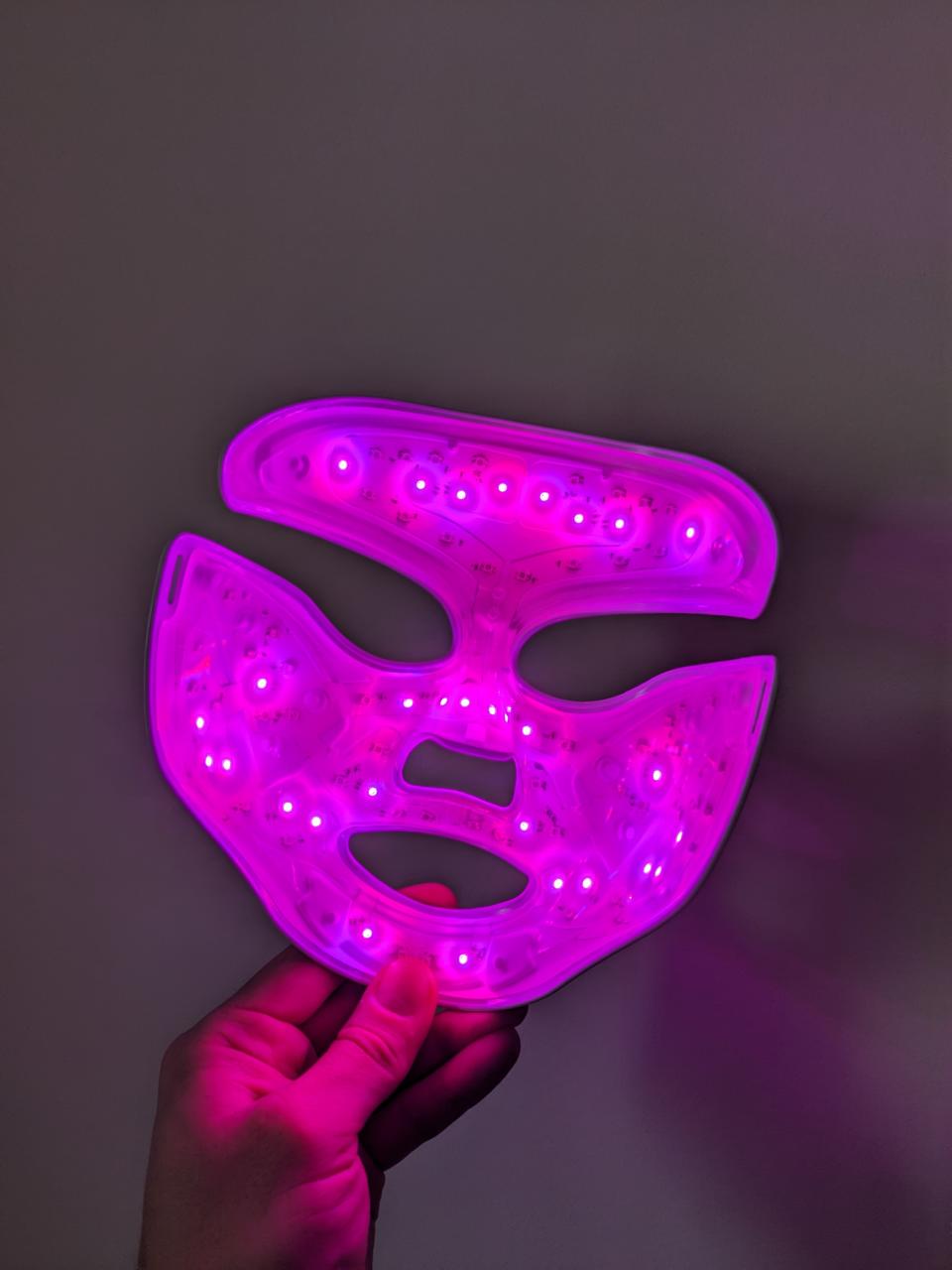
These lights have shorter wavelengths (~415nm) targeting certain forms of acne, primarily the bacteria known as P. Acnes, which is associated with inflammatory breakouts. “However, blue light is not particularly helpful for comedonal acne (like whiteheads and blackheads), or deep cystic acne that is outside of the [targeted] zone,” Dr. Rogers noted.
These at-home masks are getting closer and closer to the efficacy of clinical LLLT treatments, but they aren’t yet a viable replacement for in-office laser treatments, says Rogers. Instead, think of them as a complementary effort. “Using LLLT before and after an in-office procedure has been shown to speed recovery. And if you are good about your sun protection and regular use of LLLT you will need fewer in-office treatments to stay looking your best because there will be less skin damage to correct because your skin cells are already doing the work.”
If you are prone to hyperpigmentation, consider sticking with red-hued lights (foregoing the blue-light anti-acne efforts). “The best results with LLLT are for skin rejuvenation and wound healing using red light (640 +/- 25nm) and infrared light (880 +/-50nm),” she states. “Having a bunch of wavelengths is less important than having a quality device that is comfortable and easy for you to use for your primary goal. The data is simply not as strong for blue light.” (Nor green or yellow light, which are also sometimes used to the same end.)
As for Rogers’ recommendation for the best at-home mask, she likes those offering full facial coverage as well as larger-panel devices, as opposed to the many handheld options (which look like tiny smartphones or tablets). The options she prefers — the actual mask-like options — ensure the area is getting a uniform treatment. “For the best outcome, the device needs to be touching or nearly touching your skin to ensure the energy is being absorbed,” the doctor said.
How to Use Dr. Dennis Gross DRx SpectraLite™ FaceWare Pro
To activate the mask, hold down the button at the top of its front face, for two seconds. This activates the first mode (red/anti-aging). You can push it again to switch to the second mode (blue/anti-acne), and another time to go to the third mode (a combination of both). You can easily do all this with the mask already flush against your face. Once you are settled on your mode of choice, you simply kick back and relax for three minutes, at which point the mask automatically turns itself off. If you notice that it turns off before three minutes, then it is likely low on battery. Whenever I am low on battery while attempting the combination mode, I just switch it to red light mode and can usually finish that session before having to recharge. I find that the third mode, the combo one, depletes the battery fastest, but nominally so. I only have to charge the device every couple of weeks, despite using it daily.
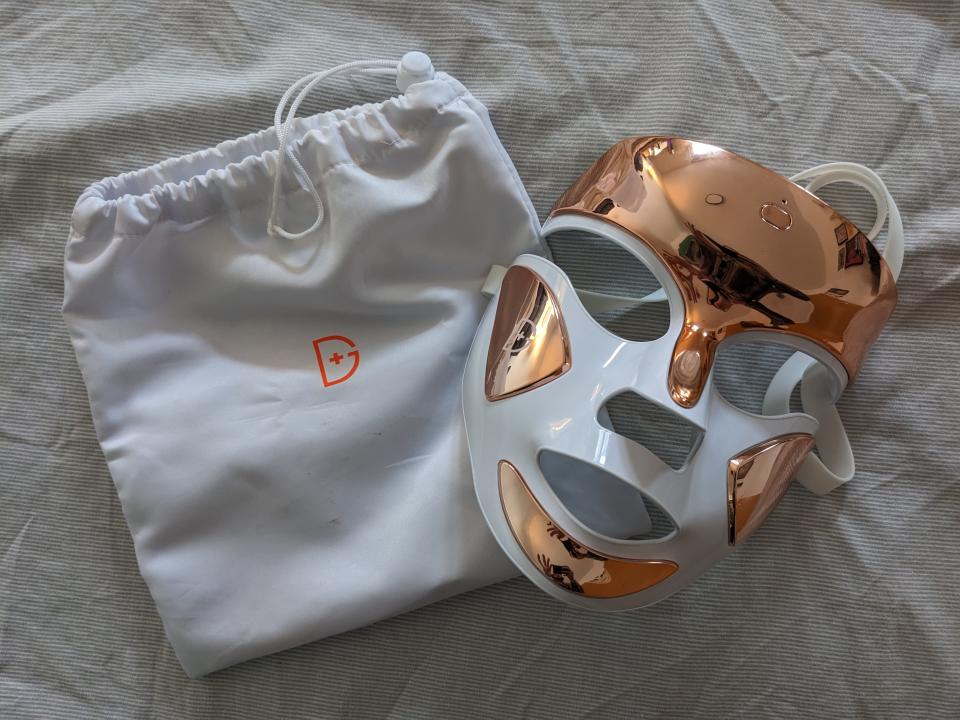
The strap, while durable and adjustable, is just not effective in my opinion. I find it uncomfortable to adjust, and it tugs at some of my hair as I fasten it into place. For that reason, I’ve been using the mask without the straps almost entirely during my seven months of using it. And that’s no problem for me; I also recommend closing your eyes during use, just so that you don’t get any peripheral LED exposure during the process. The risk here is low, and it’s well-designed enough that you probably won’t ever experience a headache or anything. But it feels a little weird to be texting or doing errands during this quick 3-minute session. Use it as a moment of peace. Listen to your favorite song with your wireless earbuds or smart speaker. Send your loved one a voice note. Just lay back, keep the mask against your face (no hands necessary), and close your eyes.
I wipe the mask down after every use, using a sanitary cleaning wipe. This prevents any buildup and bacteria, and any transfer of said grime to my face. I also cleanse with my favorite face wash before using the mask, to ensure that we’re working with a clean canvas and, again, not transferring any oil, grime, bacteria, and product buildup to the device — nor letting those things hinder its performance.
Dr. Dennis Gross DRx SpectraLite™ FaceWare Pro: Testing LED Mask
Since I’ve been using this device for over seven months, I am well beyond the minimum amount of time needed to measure results. You might start noticing a clearer complexion after a few weeks, but need up to 10 or more weeks to look at your reflection daily and say “Yep, it’s firmer.” I’d show you before-and-after pics of my own mug, but to be honest, I never believe those images, because they don’t account for things like seasonality or day-of concerns.
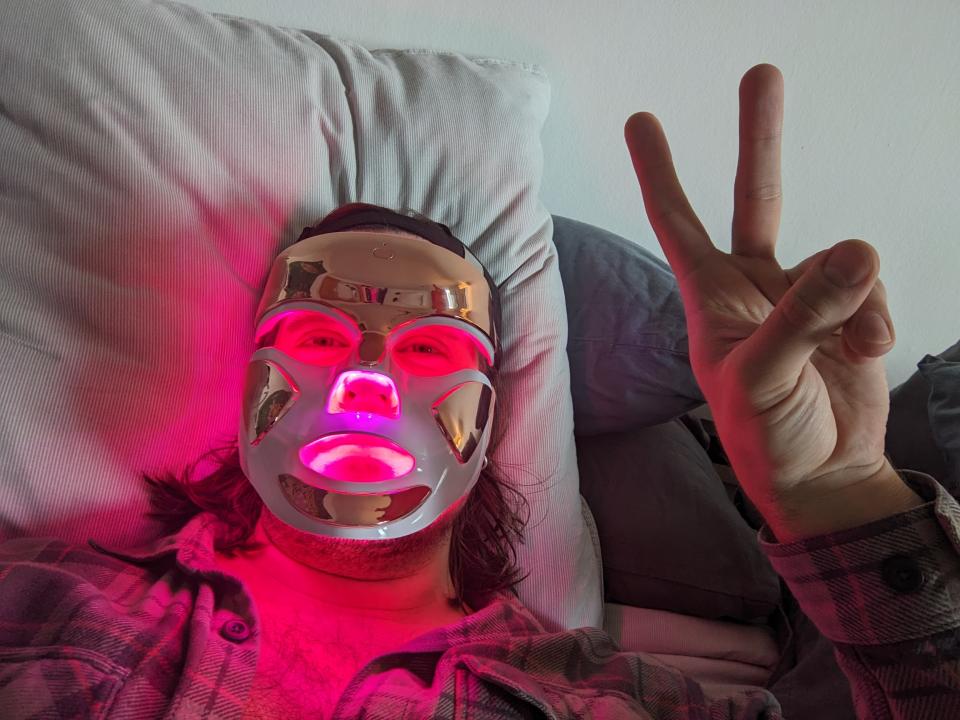
For example, my skin is paler in winter, and it’s currently the dead of winter. I’m showcasing imperfections more easily than at the height of summer when I’ve got a base tan to help even things out. Plus, on any given day I can be well rested or tired, splotchy or puffy, or neither… or something in between that. Today I look perfectly fine, but I’ve also got facial hair at present covering half of my face — so how does a B&A comparison account for all that? You instead have to take my word.
In short, the best way to notice results is a long-term period of consistent, more clear, more smooth results than what you noticed before you ever started using the device. And with this device, I can happily say that it meets the mark.

Dr. Dennis Gross DRx SpectraLite Dpl FaceWare Pro
Buy Now On Amazon
$435 at sephora
What I notice is a more “soft” complexion overall. I think the biggest difference has been in terms of skin texture. Not only does it feel less rough to the touch, but it also looks visibly smoother and softer. Firmer, too. While no mask like this can erase 36 years of expression lines from my forehead, I do feel as if it has tighter everything around those lines — and is thus likely slowing their permanent existence on my resting face.
While I still experience periodic cystic acne (a type of acne not targeted by this mask), I have noticed a decrease in one-off blemishes as well as momentary clusters of blemishes. Up until this year, I would get clusters, like three or four in the same area of my face, all at once. Still, I would say that my primary benefits have come from the anti-aging efforts, and would recommend this mask for that purpose, primarily. Nevertheless, I do choose to stick with the combination treatment, since I like thinking that I get both benefits at once. But from what I know about these masks, as Dr. Rogers confirms in this article, is that red and infrared lights are proven to be far more successful at their task than blue lights. That’s another reason I’d endorse it foremost for its red-light / LLLT / anti-aging options, even if I feel like I see results in both red and blue categories.
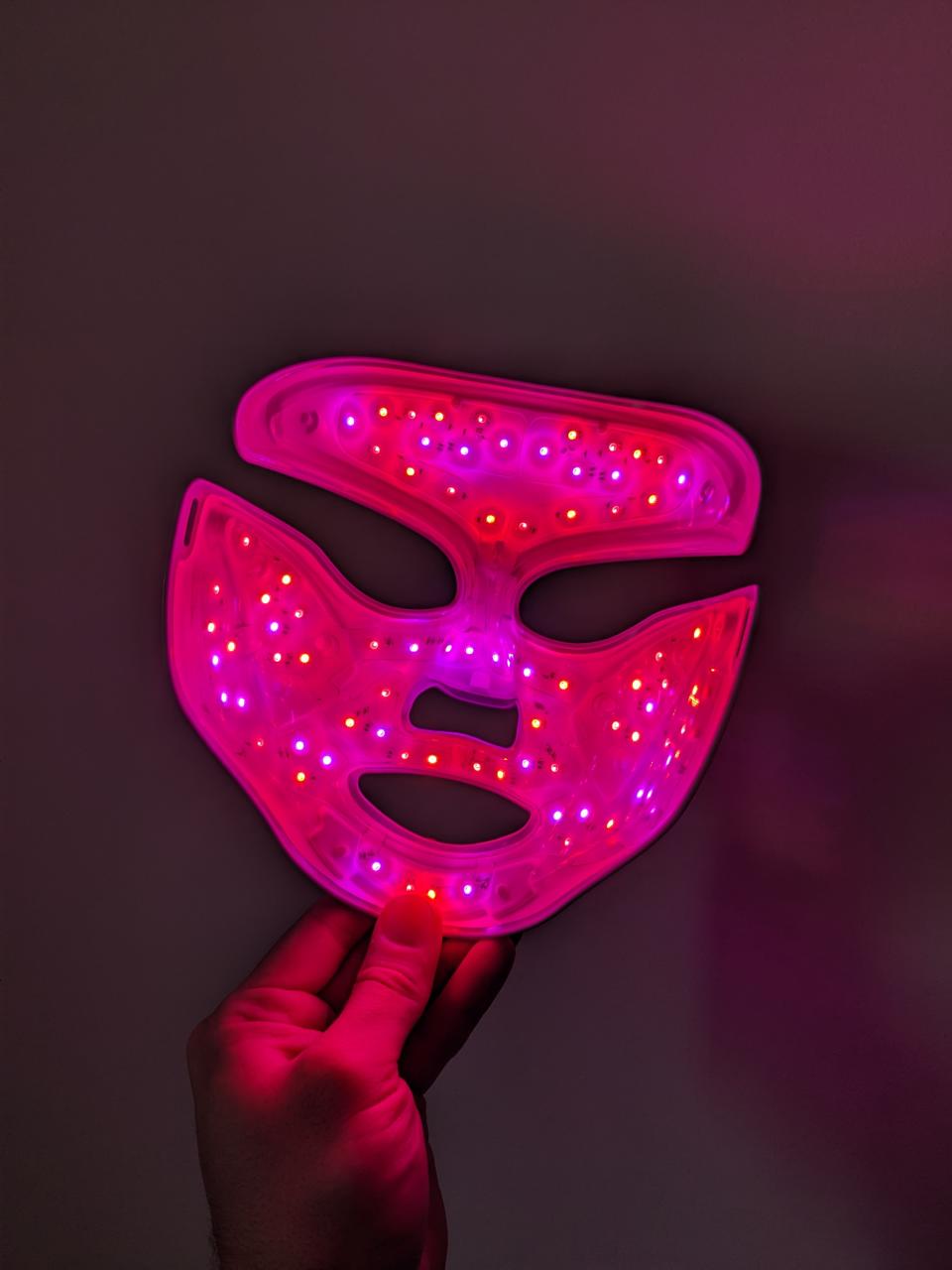
This mask never overheats, and in fact, I don’t really notice any warmth on my face due to the short duration of use. It also uses more lights than its closest competitors, some of the other top-tier ones use about 60% of the number of red lights and don’t even offer dual-use options.
Something I didn’t anticipate but that I’ve appreciated is how easily this mask fits into my backpack and carry-on luggage. It’s so easy to tote along and pack into the clothing. It’s durable, too, and since its battery lasts for about 8-10 days, I don’t even have to worry about re-juicing it, though my phone uses the same USB-C charger, so it’s not like I ever have a problem with that, either.
How to Get the Most Out of LED Masks
Dr. Rogers also gave SPY a few tips on making sure readers can get the most bang for their buck with these high-cost masks.
Be consistent. You probably won’t notice results until the first or second month, and only if you’ve been using the device as often as recommended. “Figure out your habit and stick to it,” Dr. Rogers said. “Most people find the first thing in the morning or the last step before bed easiest to do.
Start with clean skin. Dr. Rogers noted that the best face serums and moisturizers are OK to use before the treatment, but the most optimal scenario is freshly cleansed bare skin.
Dry skin might need extra help. LLLT can dry out the skin, especially if you have a device that gets you your dose of LLLT in a short period of time (like the one I’m using). Make sure to have a hydrating, nourishing skincare routine, and follow mask use with that regimen. “If you have dry skin, adding moisturizer before and after can make your skin tolerate the treatments better. She uses Celluma’s face mask ($695) and moisturizes her face, then follows it with her own brand’s healing balm all over her face to seal in water before the LLLT.
Reconsider if your eyes are sensitive to light. Dr. Rogers does not recommend LLLT for individuals whose eyes are light-sensitive. “Even when wearing eye protection, the light is still often visible and can trigger migraines or seizures for some,” she warned.
Be conscious of your skin needs and the treatment duration. Individuals with sensitive and hyperpigmentation-prone skin should focus on longer treatments with lower irradiance, Dr. Rogers advised. “Higher irradiance increases the likelihood of heat buildup, activating melasma and drying out the skin. Also, there is data suggesting too much energy delivered too fast overpowers cells and the energy is not able to be used. Instead, better outcomes are achieved with slower and lower light treatments… but anything too low will not have a biological effect.”
The Verdict: Should You Buy the Dr. Dennis Gross DRx SpectraLite™ FaceWare Pro?
I genuinely look forward to my daily LED sessions with this mask. I make my coffee, wash my face, put on a podcast, and just zone out on the bed for a few minutes until it turns off. Sometimes, I remove the mask and just keep laying there, too zenned to move. Other masks that I’ve used might deliver a more concentrated amount of lasers (10 minutes, largely infrared, compared to 3 minutes of various medium-to-long wavelength red-hued lasers in this one).
But the problem I had with those masks was remembering when to use them, and budgeting enough time for them whenever the thought occurred to me. Three minutes is the perfect amount of time to be able to use this mask every day. And even if I didn’t want to lay back in bed with it, I could re-fasten the strap and wear it as I pick out my outfit for the day, or as I make the coffee. So it gets high marks simply because I never forget to use it, and because it’s been so easy (and enjoyable) to do.
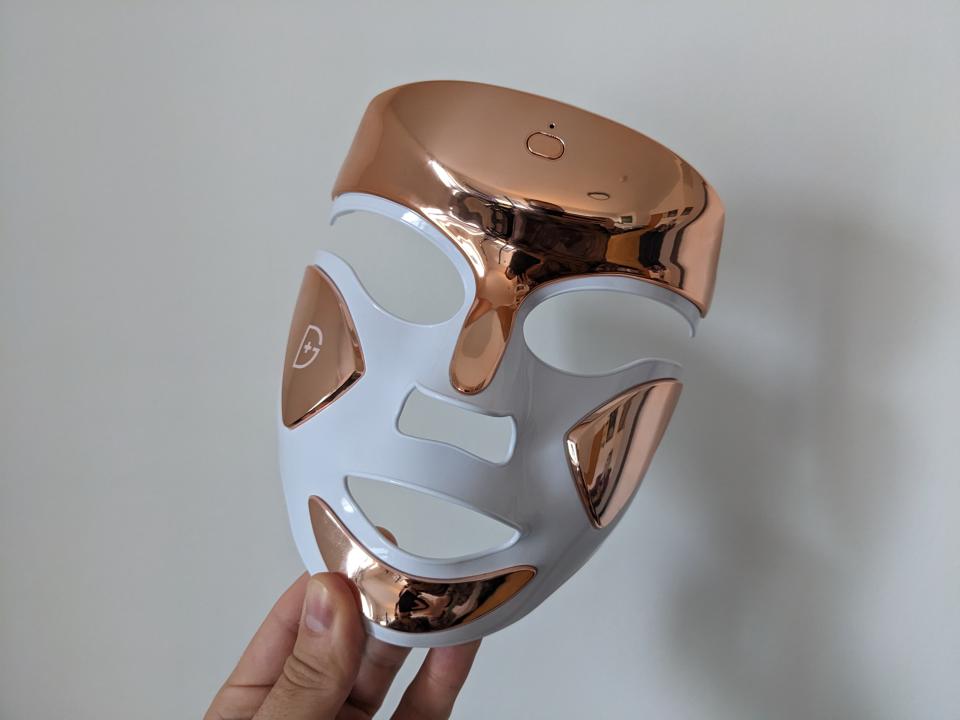
But beyond that, I have seen actual results. My skin looks and feels more soft, supple, and buoyant. I think I’ve had my best complexion of all my 36 years in the past six months or so, and I was pretty pale that whole while as well (not that pale folks can’t have a good complexion. I only mean that usually I need some kind of base tan in order to cover up some tonal/complexion issues on my skin, whereas these days, despite being pallid, I rarely ever have to use concealer). I find myself bringing up this device in conversation quite often, too, and have converted a handful of friends to using it given my own success. The lessened amount of inflammatory acne has been a huge pro, too, if secondary to the overall tightening and brightening effects.
I know there are some LED devices out there costing two to three times the amount of this one, which is already a pretty penny at $435, that probably offer a more clinical-grade LLLT and are timed in a way that suits most dermatologist recommendations. Or at least, ones offering more customization of use (for example, Dr. Rogers notes that longer treatments of lower irradiance are best for folks with sensitive or pigmentation-prone skin. This one doesn’t offer that level of customization).
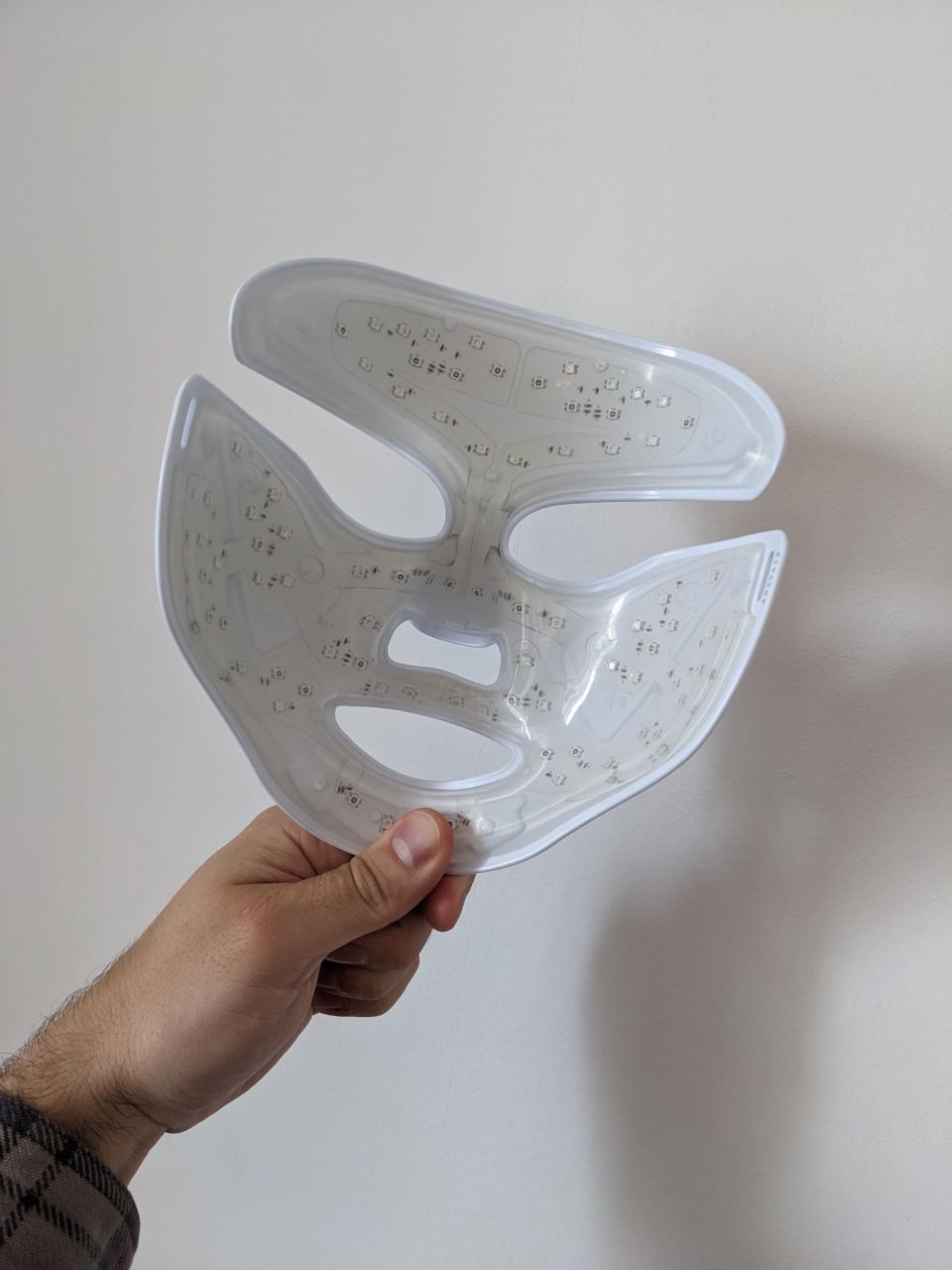
Still, if what you need is a high-performance, quality LED treatment mask from a supremely reputable doctor (Dr. Dennis Gross, like Dr. Rogers, is stratospheric in my book), then this mask is about as perfect as it gets. And considering what those clinical treatments cost, the price tag suddenly doesn’t look so steep. Remember, though, it’s not a replacement for those types of clinical laser treatments, but more of a complementary effort for them, and/or for your existing skincare regimen.
For the lack of customization and the fact that I do not care for the silicone strap, for me, this is just, barely shy of perfection.

Dr. Dennis Gross DRx SpectraLite Dpl FaceWare Pro
Buy Now On Amazon
$435 at Dr. Dennis Gross
$435 at sephora
How We Test Grooming Products at SPY
SPY introduced new product testing guidelines in 2022, and you can read our in-depth article about our new product testing and review process. When testing grooming products, we first come up with objective criteria based on the product category.
To test the Dr. Dennis Gross LED mask, we did consider a number of parameters for this and future reviews, such as the types of wavelengths and therapies offered, the ease of incorporation into one’s regimen, product design, wearability, and even cost. Products are tested for a minimum of two weeks, but LED masks require 2-3 months of use before long-term results start to show (and should also be maintained after the fact, in order to retain results). SPY Contributor, Adam Hurly, has been using the DRx SpectraLite™ FaceWare Pro for over seven consecutive months (and counting).
About the Author
Adam Hurly has been covering the grooming industry for a decade after getting his start at Birchbox in 2013. Since becoming a freelance journalist in 2016, he has written for nearly every men’s title. In addition to SPY, his frequent clients include GQ, Men’s Journal, Robb Report, Forbes, and more. Hurly is a South Dakota native, a University of Kansas graduate, a New Yorker at heart, and has resided in Berlin for 5 years.
Recently at SPY, Hurly has highlighted the best acne patches, laid out the best hair loss treatments, and has even shared his secret to packing the perfect Dopp kit.
More Top Deals from SPY
Best of SPY

